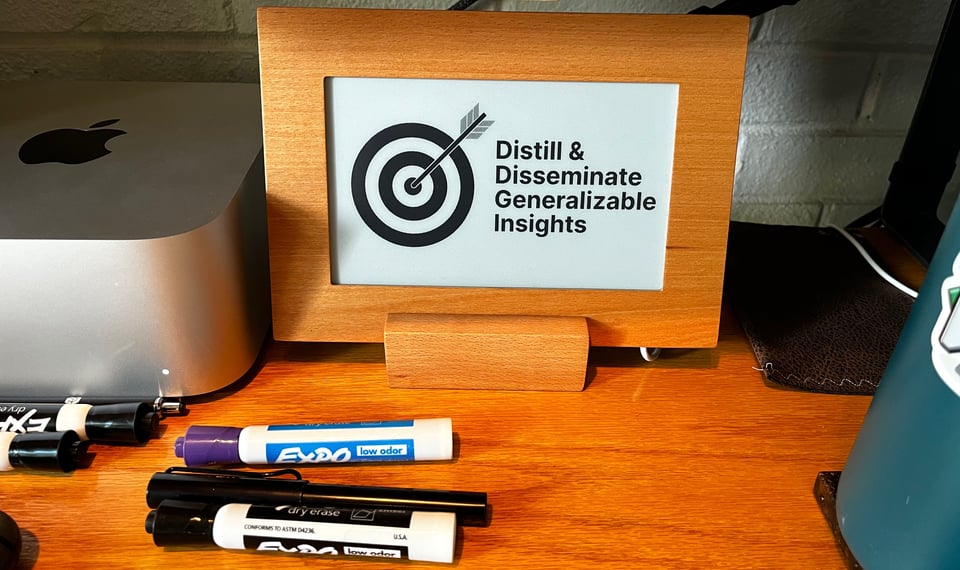Reshape your notebook, reshape your brain

Reshape your notebook, reshape your brain
The past few weeks I've been re-organizing my personal Lab Notebook in order to better orient myself around my goal of Discovering and Disseminating Generalizable Insights to enable computers to help us think better, together.
"Re-organizing my notebook" sounds suspiciously like busy work. Why have I invested 10-20 hours into it over the past few weeks? Simply to make it easy to do the right thing. I believe we have the opportunity to architect our environment such that we can accomplish goals merely by being in sync with our surroundings. Putting my lab notebook into order is putting that principle into practice.
Recall the (simplified, idealized) process for discovering and disseminating generalizable insights:
Identify powerful insights
Build systems which express those insights
Observe serious use of those systems in authentic contexts
Distill generalizable insight from those observations which produce new understanding about the subject domain
Disseminate that insight so that others can build on it
In my re-organization, I've taken that process literally as a sort of Research Pipeline and organized my notebook around those core areas:
Evergreen Notes: my Evergreen Note-taking notes, many of which contain the seeds of intuitive insights that need development.
Projects: a list of projects that I am working or have worked on. Also a source of insight, and some of which can be developed into Experimental Systems.
Open Questions I'm Pondering is sort of a switchboard for Good Questions, which are the essential starting point for research.
Intuitive Insights: a list of insights I've had about systems that await embodiment in an Experimental System.
Experimental Systems: a list of Experimental Systems that I've worked on in the past or am building now.
Resources, People and Systems: notes on influential researchers and software systems that have shaped computing over the decades.
What's missing from the pipeline?
Observations: close studies of Experimental Systems such that a result can be determined to confirm the Intuitive Insight is worthy of distillation into a generalizable form. I don't have any of these yet!
Generalizable Insights: these are the gold nugget, an insight that generalizes to the creation of other systems. This is the goal, and I certainly don't have any of these yet.
Ship your brain
Beyond the personal benefit of arranging my lab notebook to streamline learning and discovery, I'm also publishing large swaths of my notebook as an effort to share my progress more organically with others.
Disseminating results in tools for thought research looks a little different than traditional academia where h-index and the publication of papers in journals are most prized. I've benefited tremendously from the "lab notes" of Andy Matuschak, Alexander Obenauer, and others. By publishing my own notes, I hope they can benefit others in some small way.
So far, the modified lab notebook has already paid dividends: I'm reading and writing my own notes differently, more intentionally considering what open questions or intuitive insights I'm developing. This has led to making concrete a couple of lines of thinking that were previously floating about in my brain. Categories can be tremendously useful, like scaffolding for my own thinking.
Feel free to go poke around in my Lab Notebook and reach out if you have any questions or reactions!
Glimpses of the future
I'm intrigued by the idea of plaintext as a data store with many views and two interesting projects popped up this week that leverage plain Markdown to generate an alternate view.
One mapping I know quite well, having built several versions of it myself: Markdown todos ➡️ Kanban. Imdone.io gives you a nice Kanban UI on top of markdown files. I love how they've extended the Markdown to embed the Kanban features in the plaintext. It hearkens back to the venerable TaskPaper.
The other discovery maps Markdown onto Calendaring and Planning, to great effect: MarkWhen. I love how they use a plain-text data structure and presenting the data using many views, from calendar to a timeline and even a map! Truly multi-media. Check out the interactive demos on the website.